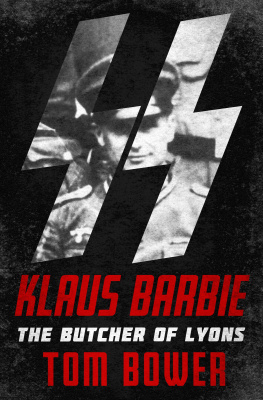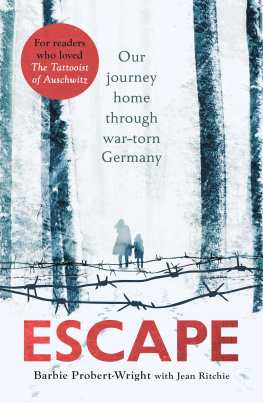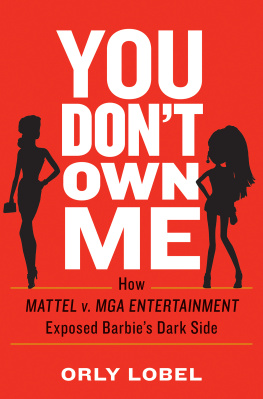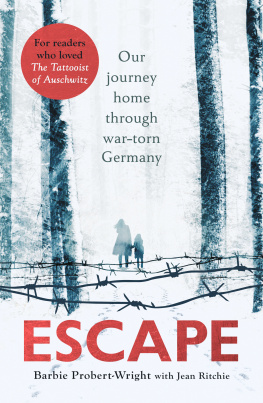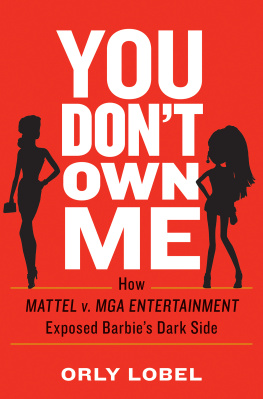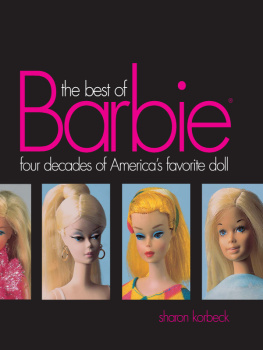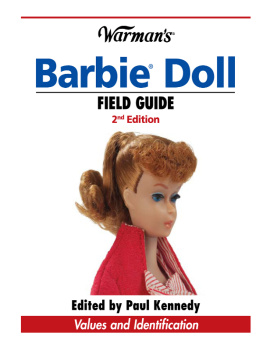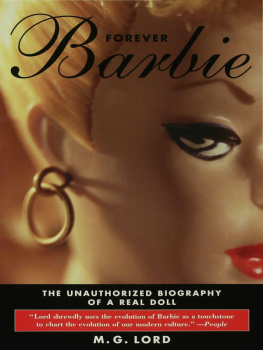B ARBIE QUITE SIMPLY CHANGED MY LIFE. Since 1959, millions of children around the world have fallen in love with the most popular fashion doll ever created. Barbie wasnt only a stylish toy, she also nurtured imaginations, which was what Ruth Handler had envisioned when she created the eleven-and-a-half-inch teenage fashion model.
Of course I was aware of Barbie when she debuted in 1959. You couldnt miss her. Ruth Handler and her husband, Elliot, had done a masterful job with Barbies launch; in magazines, newspapers, or on television, someone was always talking about Barbie. I went to a toy store to check her out, and I can still recall my first in-person glimpse of her, with her sideways glance, wearing her now-iconic black-and-white-striped bathing suit and heels. I remember thinking Barbie looked important.
That turned out to be quite the understatement. Over six decades, Barbie and her friends have spawned an incredible wealth of adventuresmany originated from her design team, who created a universe that included an ever-expanding roster of professions, dream houses, modes of transportation, a wide-ranging wardrobe that combined fashion trends with a liberal dose of fantasy, and so much more. Children everywhere embraced this world and enhanced it via the stories they created as they played, which was key to Barbies success.

The first Barbie doll, 1959.
Photo by Carol Spencer
For thirty-five years, I was at the center of that universe as a member of Mattels design team. It wasnt a career I had ever envisioned when I was younger, but from that moment in 1962 when I first read Mattels advertisement in Womens Wear Daily, I saw my future, and it thrilled me.
Perhaps thats because Barbies life was the polar opposite of my own: she was the ultimate California girl, while I grew up in Minneapolis, where the winters were gray and seemingly endless. Barbie could take on any profession she desiredshe was an astronaut in 1965, four years before the Apollo 11 moon landingbut when I was thinking about a career in the late 1950s, the options available to women largely focused on the expected five: nurse, teacher, secretary, shopgirl, and seamstress. My older sister, Margaret, had become a nurse, and all my friends at Washburn High School in South Minneapolis likewise seemed to easily accept these choices. I always knew, however, that I wanted more.
The only exception? I really loved to sew and still do. In 1937, when I was four years old, my father died unexpectedly, and my mother, sister, and I moved from Dallas, Texas, to Minneapolis, Minnesota, to live with my Aunt Lena, Uncle Lincoln, and my grandmother. Getting used to the snow and cold was a big adjustment, but I quickly bonded with my grandmother, who was incredibly talented with a needle and a sewing machine, and she instilled in me a fondness for these skills. I was mesmerized by her ability to create a beautiful dress from pieces of fabric, and as I watched her, my face would inch ever closer to the sewing machine. I can still hear her say, I will stitch your nose to the garment if you dont move farther away.

My sister, Margaret (right), and me with our Aunt Lena, 1937.
Aunt Lena and Uncle Lincoln, who had no children of their own, truly became surrogate parents for Margaret and myself when our mother passed away from a stroke while we were in high school. Eventually the four of us were very happy in that Minneapolis home.
As my high school graduation approached in 1950, however, those expected life choices loomed before me, and I was feeling restless. Thats also because I had found myself somewhat committed to a sixth option: wife and mother. His name was Neil: he and I had dated throughout high school, and everyone around us expected the next natural stepincluding Neil. His family had decided we would get married after graduation and I would get a job so I could support him while he went to medical school. He had not given me a ring, and no date had been set. Yet increasingly, I didnt like the idea that my life had been planned out for me.
I want more, I thought.
One Sunday while reading the newspaper, I spied an ad for a seminar highlighting jobs in the fashion industry. I put on my best interview clothes and my bravest face, and I didnt tell anyone where I was going. The first speaker was a member of the Fashion Group International, Inc., who discussed the fashion design program at the Minneapolis School of Art. She put two words together that I had never heard of as a vocation: fashion designer. It was as though someone had turned on a light. Before leaving the seminar, I filled out an applicationand when I returned home, I still didnt tell anyone.
I watched the mailbox every day for weeks until an envelope with my name on it finally arrived: I had been accepted! That feeling of wanting more suddenly no longer made me feel restless; instead, it was exhilarating.
It was time to tell Neil. His father used to drive us on our dates, he in the front seat, Neil and I sitting side by side in the back seat. Anything I discussed with Neil, his father would be privy to. So I shared my news, telling my fianc how excited I was about the opportunity and suggesting that we both could go to school, but that meant I would be unable to work and help pay his tuition. But the next day, the decision was made: our engagement was over.
More than anything, I felt relieved. And I couldnt wait for what was next.
Today the Minneapolis School of Art is known as the Minneapolis College of Art and Design, and in the early 1950s, I was among just 250 students, many of whom were World War II veterans studying on the GI Bill. On most days, I was able to catch a ride with a former GI who decided to study sculpture after he had worked on the restoration of Mount Rushmore. And instead of the sweater-and-skirt combination that had practically become my high school uniform, in college I wore blue jeans most daysjust like the guys.
This newfound freedom also came with challenges. I loved studying basic design, color, and painting, though when it was time to take Life Drawing, I discovered I was the only woman in the class alongside thirty older, male studentsand, in the center of the room, nude models. I hid behind my drawing board the first few days, until I realized it was silly to be self-conscious. We were too busy learning about perspective, proportion, and shading to be embarrassed or titillated.
Another favorite memory was when Oskar Kokoschka, the Austrian expressionist painter, came to our school to give a seminar. My textbook called him a giant of modern art, and I read everything I could find about him. He was in his sixties when he visited us, cutting quite the dramatic figure with his white hair and keen eyes.


